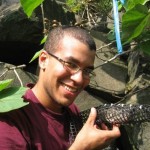 The Allegheny woodrat (Neotoma magister) is a rodent native to cliff edges, caves and talus slopes of the Appalachian Mountains (Allegheny woodrat range map). It has been disappearing from the northern portions of its range for more than 30 years. In my research I have studied the importance of various factors believed to have affected the population biology of this species. Most of my research has focused on Baylisascaris procyonis or raccoon roundworm, a nematode parasite of raccoons. This parasite produces environmentally resistant eggs that are extremely pathogenic if ingested by non-raccoon hosts (life cycle of parasite).  In the 1990’s, I conducted a study that confirmed that raccoon roundworm is a significant source of mortality in NY and NJ woodrats. Behavioral research has helped to explain why woodrats are more vulnerable to this common parasite than other rodents. Sadly, the Allegheny woodrat is extirpated from New York State and occupies only a single site in New Jersey. In more recent years, I have participated in annual monitoring of the NJ population and I have worked with managers in Pennsylvania and beyond to develop a plan to stabilize the species. I have served as an advisor to the New Jersey State Endangered and Nongame Species Program as they have attempted a genetic rescue of the remaining New Jersey population. Relevant Publications: LoGiudice, K. 2008. Multiple causes of the Allegheny woodrat decline: A historical-ecological examination. In: The Allegheny Woodrat: Ecology, Conservation and Management of a Declining Species. John D. Peles and Janet Wright (Editors). Springer-Verlag Publishers. LoGiudice, K. 2006. Toward a synthetic view of extinction: A history lesson from a North American rodent. BioScience. 56:687-693. LoGiudice, K. 2003. Trophically transmitted parasites and the conservation of small populations: Raccoon roundworm and the imperiled Allegheny Woodrat. Conservation Biology. 17:258-266. LoGiudice, K. 2001. Latrine foraging strategies of two small mammals: Implications for the transmission of Baylisascaris procyonis. American Midland Naturalist. 146:369-378. |
| Woodrat links |